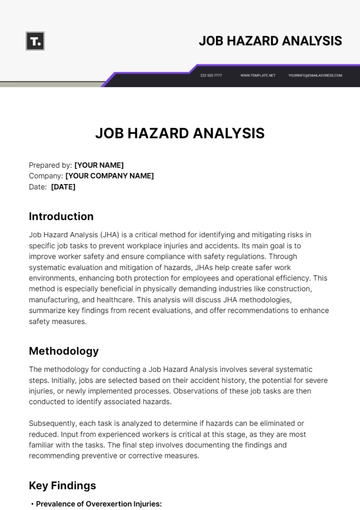Free Restaurant Inventory Analysis

I. Executive Summary
The purpose of this Restaurant Inventory Analysis is to provide a comprehensive review of inventory management practices, identify inefficiencies, and suggest improvements. This analysis aims to help [Your Company Name] optimize its inventory levels, reduce waste, and improve profitability. By evaluating current inventory tracking methods, turnover rates, and costs, we can identify key areas for enhancement.
Our analysis delves into item utilization patterns to distinguish between high-demand, seasonal, and low-demand items, thereby facilitating more accurate ordering and minimizing waste. Additionally, we assess supply chain efficiency, focusing on supplier reliability, order fulfillment accuracy, and delivery times, which are critical to maintaining a consistent and efficient inventory system.
The recommendations provided are designed to help [Your Company Name] implement best practices in inventory management, such as adopting advanced inventory management software, conducting regular inventory audits, and evaluating supplier performance. These steps will ensure better inventory control, reduced costs, and improved overall profitability. Through this analysis, [Your Company Name] can make informed decisions to streamline operations and enhance its competitive edge.
II. Current Inventory Management Practices
This section explores the existing inventory management practices at [Your Company Name]. We assess the methods used for inventory tracking, analyze inventory turnover rates, and review associated costs. Understanding the current practices is essential for identifying areas of improvement and implementing effective strategies.
A. Inventory Tracking Methods
Manual Tracking
Manual tracking involves physically counting inventory items and recording data on paper. While this method can be straightforward, it is prone to human error, time-consuming, and difficult to scale as inventory grows.
Spreadsheet Management
Many restaurants, including [Your Company Name], use spreadsheet software like Excel or Google Sheets to track inventory. This method offers more organization than manual tracking but still requires significant manual data entry and is susceptible to errors.
Inventory Management Software
Investing in inventory management software can streamline processes, improve accuracy, and provide real-time data. Software solutions offer features like automated reordering, low stock alerts, and detailed reporting, helping restaurants make informed decisions.
B. Inventory Turnover Rates
Table 1 below shows the inventory turnover rates for [Your Company Name] over the last six months. Inventory turnover rate is a crucial metric indicating how often inventory is used and replenished within a specific period. A higher rate suggests efficient inventory management, while a lower rate may indicate overstocking or slow-moving items.
Table 1: Inventory Turnover Rate (Last 6 months)
Month | Turnover Rate |
|---|---|
January | 4.5 |
February | 4.7 |
March | 4.2 |
April | 4.6 |
May | 4.8 |
June | 4.4 |
C. Inventory Costs
Inventory costs can be categorized into three main areas: storage costs, staffing costs, and order costs. Understanding these costs is essential for effective inventory management.
Storage Costs
Storage costs include expenses related to storing inventory, such as rent, utilities, and refrigeration. Efficient inventory management can help reduce these costs by minimizing the amount of stock that needs to be stored.
Staffing Costs
Staffing costs involve the labor required to manage inventory, including ordering, receiving, storing, and tracking items. Automating inventory processes can reduce labor costs and free up staff to focus on other tasks.
Order Costs
Order costs include expenses related to placing and receiving orders, such as shipping, handling, and administrative costs. Reducing the frequency of orders through better inventory forecasting can help lower these costs.
III. Analysis of Inventory Data
In this section, we analyze inventory data to understand item utilization patterns, waste sources, and supply chain efficiency. This analysis helps identify high-demand, seasonal, and low-demand items, as well as areas where waste occurs and how the supply chain impacts inventory management.
A. Item Utilization
Understanding item utilization helps identify which items are in high demand, seasonal, or low demand. This information is crucial for making informed purchasing decisions and reducing waste.
High-Demand Items
High-demand items are those frequently used in daily operations. Ensuring adequate stock levels of these items can prevent shortages and disruptions.
Seasonal Items
Seasonal items have fluctuating demand based on the time of year. Properly managing these items requires anticipating changes in demand and adjusting orders accordingly.
Low-Demand Items
Low-demand items are rarely used and can tie up capital if overstocked. Identifying and minimizing the stock of these items can improve cash flow and reduce storage costs.
B. Waste Analysis
Waste analysis involves identifying areas where waste occurs, such as perishable items, over-order quantities, and incorrect storage practices.
Perishable Items
Perishable items have a limited shelf life and are prone to spoilage if not used promptly. Implementing a first-in, first-out (FIFO) system can help reduce waste.
Over-Order Quantities
Over-ordering leads to excess inventory that may not be used before it expires. Accurate demand forecasting and order planning can prevent this issue.
Incorrect Storage Practices
Improper storage practices, such as incorrect temperatures or humidity levels, can cause spoilage and waste. Regularly training staff on proper storage techniques can mitigate this risk.
C. Supply Chain Efficiency
Supply chain efficiency impacts the reliability, accuracy, and timeliness of inventory deliveries. Evaluating supplier performance and optimizing supply chain processes can enhance efficiency.
Supplier Reliability
Reliable suppliers ensure consistent delivery of high-quality products. Regularly evaluating supplier performance can help identify issues and make informed decisions about supplier relationships.
Order Fulfillment Accuracy
Accurate order fulfillment is crucial for maintaining the right inventory levels. Tracking discrepancies between orders and deliveries can highlight areas for improvement.
Delivery Times
Timely deliveries are essential for maintaining adequate stock levels. Assessing delivery times and working with suppliers to ensure prompt deliveries can improve inventory management.
IV. Recommendations
Based on the analysis, we provide several recommendations to improve inventory management at [Your Company Name]. These include implementing inventory management software, conducting regular audits, and evaluating supplier performance to ensure efficient and cost-effective operations.
A. Implement Inventory Management Software
Adopting a robust inventory management system could greatly improve accuracy and efficiency. Features like automated reordering, low stock alerts, and detailed reporting can help [Your Company Name] make informed decisions and reduce manual labor.
B. Regular Inventory Audits
Implementing regular audits ensures data accuracy and identifies discrepancies early. Regular checks can help maintain accurate inventory records and highlight areas for improvement.
C. Supplier Evaluation
Evaluating and possibly renegotiating terms with suppliers can improve reliability and reduce costs. Building strong relationships with reliable suppliers ensures consistent product quality and timely deliveries.
V. Conclusion
By addressing the identified inefficiencies and implementing the recommended improvements, [Your Company Name] can better manage its inventory, reduce costs, and enhance overall profitability. Effective inventory management is crucial for maintaining operational efficiency, reducing waste, and improving the bottom line.
VI. Contact Information
For further information or inquiries, please contact:
Name: [Your Name]
Email: [Your Company Email]
Phone: [Your Company Number]
- 100% Customizable, free editor
- Access 1 Million+ Templates, photo’s & graphics
- Download or share as a template
- Click and replace photos, graphics, text, backgrounds
- Resize, crop, AI write & more
- Access advanced editor
Gain invaluable insights into your restaurant's inventory management with Template.net's Restaurant Inventory Analysis Template. This powerful tool facilitates comprehensive analysis of stock levels, usage patterns, and cost efficiency. Fully editable and customizable using our intuitive AI editor tool, it empowers you to optimize inventory practices to minimize waste and maximize profitability. Streamline your inventory analysis process and take control of your restaurant's supply chain, exclusively at Template.net.





























